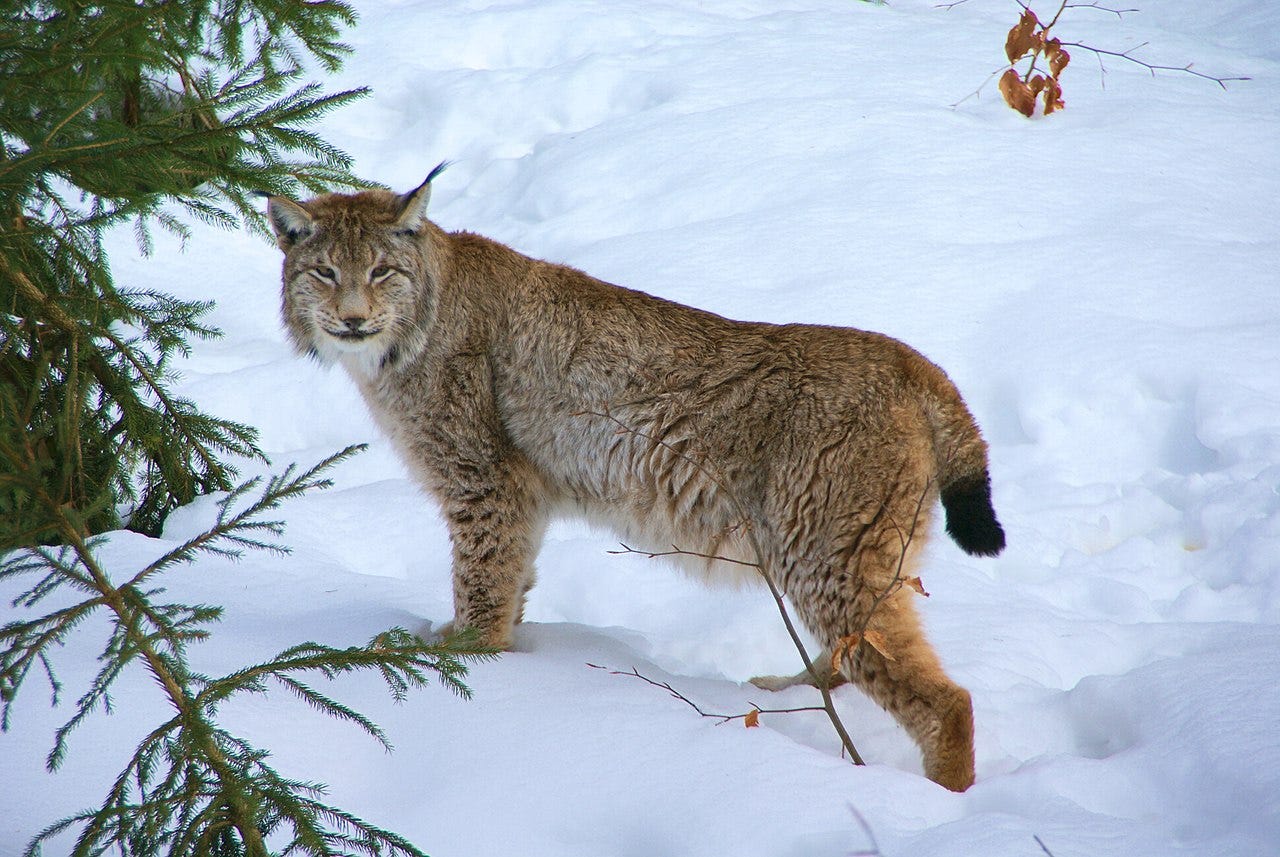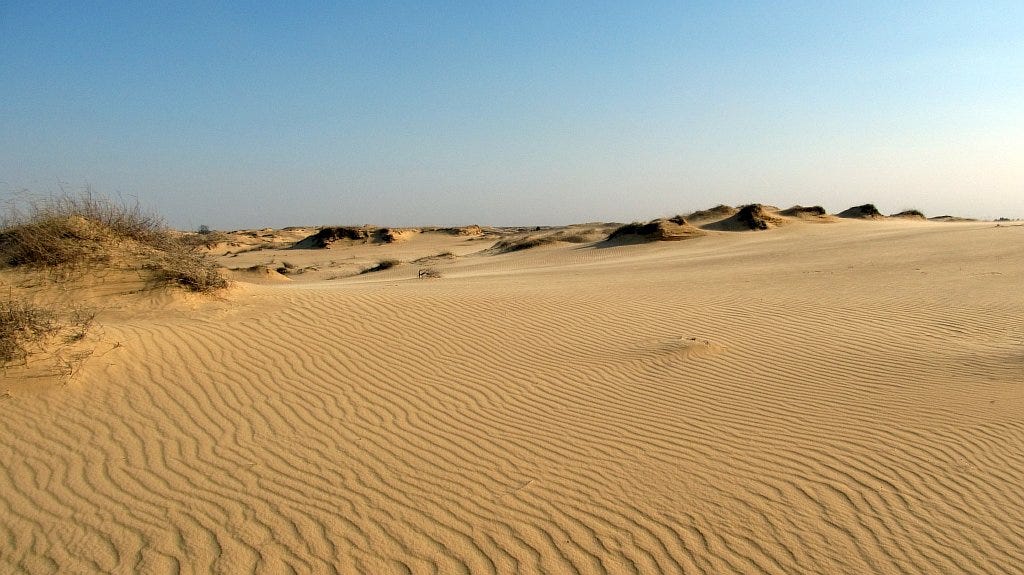It was my favorite salad newsletter, of all things, that got me wondering about wildlife in Ukraine at this particular difficult moment.
Like all the best newsletters, the Department of Salad newsletter is much more than a salad newsletter. It’s also a musing on agism in journalism, especially if you’re a woman; it’s a fun rummage through Emily Nunn’s extensive rolodex of writers and artists; and it’s a creative exploration of all kinds of pairings of fruits, veggies, and proteins. And sometimes, it’s a reflection on our times. Her recent entry, including recipes for Ukrainian radish slaw and borscht, was one of the latter.
Which is what got me to thinking about the wildlife in Ukraine.
First of all, once I started looking into it, I was surprised at just how much wildlife lives in Ukraine. It has 16 national parks and reserves. (And maybe more? That’s a commercial site that sited the 16 parks — another site mentioned 49 national parks? It was hard to nail down.)
What I am sure about is that Ukraine has eight U.N.-designated biosphere reserves — compare that to the (much larger) United States’ 28. The Danube Delta Biosphere Reserve is home (at least some of the time) to 312 bird species; 90 fish species; European mink, the wildcat; the freshwater otter, and the globally threatened monk seal.
Source: Wikimedia, from page on European Mink
The primeval forests of the East Carpathians Transboundary Biosphere Reserve provides suitable habitat to such large mammals as the European brown bear, the European bison, the Eurasian lynx, and the European wolf.
Source: Aconcagua on the Wikipedia Eurasian Lynx page.
And that’s not even the crazy one! Maybe you expect some mountainous regions in Ukraine. Maybe you see something with the word “Danube” in it and think — as I did — oh, yeah, the Danube. Sure. I guess that makes sense. Sailing up the Danube. It can’t begin and end in Germany.
But what I did not expect — and was completely taken aback by — was a desert region. The “Oleshkovsky Sands” were formed at least in part by deforestation and overgrazing in the previous two centuries, a trend which was eventually brought to a halt through the implementation of a pine forestry program. What remains, though, is a kind of mini-Sahara. It’s not a desert really — it’s not a desert climate naturally, more like a semi-arid one — but it is very sandy, and plays host to all kinds of unusual flora and fauna.
Source: НПП "Олешківські піски" on the Wikipedia page for Oleshky Sands.
In other words, I should be hauling out my (hefty) nature travel wishlist and adding Ukraine to it, instead of pausing mournfully after each new realization.
War can have a devastating impact on the environment. A 2016 literature review that examined 144 case studies to understand the effects of war on wildlife (War and Wildlife: Linking Armed Conflict to Conservation) summarized their findings as follows:
• Armed conflict has a largely detrimental effect on wildlife habitat and populations through tactical military strategies and effects on institutions, movement of people, and economies
• The most common pathways linking conflict to wildlife arise from institutional and socioeconomic changes associated with conflict, rather than directly from military tactics
• Conflict generates complex social and environmental dynamics over space and time, and the effects of conflict on wildlife differ across regions and taxa
• Because armed conflict frequently overlaps with biodiversity hotspots, an improved understanding of the links between armed conflict and wildlife can help to inform effective long-term management and conservation
It’s interesting to me that, according to the authors of this review, the nature is most often harmed, not by the fighting itself, but rather by the “institutional and socioeconomic changes associated with conflict.”
Ukraine’s Ministry of Ecology and Natural Resources regularly releases a “Record Of Environmental Damage Inflicted By Russian Aggression In Ukraine,” and their experience seems in line with this theory. The Ministry’s most recent release, dated March 15, 2022, lists a wide variety of concerns, many of which are pollution-related, down-stream effects of conflict, including:
• Damage is incurred to water supply and sewerage systems and communications, which directly threatens accidental pollution of rivers, which are sources of water for industrial, municipal enterprises and the population;
• There is local (but significant in its consequences) pollution of groundwater and surface water due to large-scale spills of petroleum products from blown up tanks and other actions;
• Russian troops are attacking port infrastructure along coasts of Black sea and Azov sea and ships at anchorages, which leads to contamination of waters and spread of toxins to the sea.
Despite the devastation wrought by war, on his Revelator website, author John R. Platt notes that Ukraine’s environmental groups have set aside their regular jobs for the moment — they know it’s a lost cause.
Instead, they’re going straight to the source of the problem, re-allocating their funds and resources to the fight itself. They’re hosting refugees in their offices, using their organizational skills to deliver medicine, and using their drones — normally employed in such projects as documenting bird counts — to document evidence of war crimes instead.
There is something odd that can sometimes happen after war or disaster, or in a pause of war or after a disaster. It is not a benefit of war or disaster, but it is a truth of it. And that is that sometimes, what has happened is so terrible (as in Chernobyl), or is so inextricably conflicted that the humans involved walk away, ceding the land to nature.
I have been to one such place, the DMZ. The Korean War roiled that peninsula for three years; then for more than half a century, almost no one has set foot in the 3-to-12 mile strip that separates North and South Korea. E.O. Wilson apparently called the DMZ “Yosemite and Gettysburg rolled into one.” Scientists believe that the Asiatic black bear, lynx, and perhaps even the Amur tiger have all made a comeback in the DMZ.
Source: Appaloosa, on the Wikipedia page for Amur Tiger.
There’s a bridge in the DMZ that crosses from North to South Korea; to me, it looked like being afraid of heights feels. Like you might not be able to stop yourself from tossing yourself over the edge. Like you might start running, just to see if, just maybe, you could spot a tiger before someone shot you. I did not start running. It was a scary bridge.
(I was told that, when President Clinton visited, he *did* step over the line, walking just a few feet into North Korea before some extremely panicked handlers came and hauled him back into the South. He was not, I suspect, doing it to see if he could get a better view into the DMZ’s nature preserve, but who knows? I mean, have *you* seen a black-faced spoonbill? Maybe he did and was so entranced, he just kept walking.)
“World’s Most Dangerous Golf Course” — in the DMZ
Even in Ukraine, something like this has already happened once before, in the Donbas Region where fighting with Russian forces broke out in 2014. (emphasis mine)
Before the fighting began, several nature reserves were responsible for protecting Donbas’ remaining steppe, chalk hills, wetlands and coast. One of these was Meotida National Park, in the south Donetsk region.
The war has cut the park in half — and been disastrous for those who manage it. Its headquarters in Novoazovsk, now on occupied territory, was sacked in the summer of 2015. Cars, boats, computers and the fruits of 15 years of research were lost. Nadia Dolgova, the park’s director, rescued what she could in three car trips across the frontline, until she and her husband were stopped at a separatist checkpoint and detained for several hours because the salvaged items included maps, binoculars and a Ukrainian flag.
Nevertheless, said Dolgova, who is now based in Urzuf, “The war has been good for our park. No hunting. No one shoots birds. No systematic disturbance from people and dogs. Yes, there’s frequent [military] fire, but birds get used to that, just noise doesn’t scare them.”
The park is known for its more than 240 bird species, including 100 breeding species. Its colony of Dalmatian pelicans — the only one in Ukraine — is now on separatist territory and was reportedly devastated by military action and fishing. But a few have been sighted on this side of the frontline, and last year Dolgova’s staff observed great white pelicans, the first recorded sighting in the area for 150 years.
The increased military presence along the coast and frontline has made a nesting colony of greater black-headed gulls inaccessible to fishers, poachers and curious tourists. It is flourishing as a result. “Now, there’s 24-hour guard and 3 to 4 kilometers under systematic patrol,” said Dolgova — a level of security that was impossible for the park even in the pre-war days when it had vehicles and a fuel budget.
The increased presence of armed men is a mixed blessing though. Soldiers like to try out their rifles and night-vision goggles on wild boar and deer, said park staff and hunters who say they have found the vehicle tracks and dead animals to prove it.
Dolgova complained to a military commander: “They explained that they were practicing: ‘There’s a war on in the country and where should we practice, on people or animals?’”
Surely, a catastrophic situation — even one that ends in a re-wilding of a certain area — cannot be considered a desirable end.
I keep returning instead to the Ukrainian environmentalists, engaged first in the fight for conservation, and now in the fight for their country. They’ve redirected their drones, they’re using their networks to dig out the war like some big, invasive species, an enormous tuber root that endangers them and the land and nature that they’ve dedicated their lives to. How does this fight feel to them? How does one fight remind them of the other?
If you happen to find yourself with extra money at the end of the month, you might consider giving some to the Danube-Carpathian Program using the instructions on the Eurosite website, which explains a little more about what environmental groups are doing for refugees and others in need at this time. Alternately, you could consider contributing to the World Central Kitchen, José Andreas’ organization, which is providing meals and culinary training to those in need in Ukraine and globally.
Thanks for reading, and I hope you have a wanderful week.









How wonderful to help or try to help Ukraine's people and animals too! and as serendipity there's food--both for World Central Kitchen and our own kitchens--I hope to cook the Ukrainian radish slaw soon. Thanks, Dear, from your very own Mom
You put a lot of work into this one. I didn't know anything about nature in Ukraine, and now I do.